
views
Drawing a Food Pyramid

Draw a large pyramid on a piece of paper. The symbolic meaning of the pyramid – wide base that narrows to a point at the top – parallels the amount of each food group you should include in your daily diet. Although the modern version of the pyramid takes into account physical activity, age, and gender, the original concept design was to illustrate that a variety of foods need to be consumed in differing amounts to maintain a healthy diet. Divide the paragraph into four sections by drawing three horizontal lines across the pyramid. The base, or bottom level, should run the entire width of the pyramid. The next two levels should be split down the middle by drawing a vertical line in the center of each level. The top level, or peak, should be its own level. Since there are a great variety of foods that you consume during the week, make sure the pyramid is large enough to enter multiple food names within the structure of the pyramid.
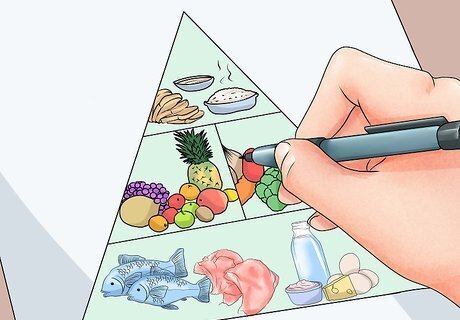
Label each section of the pyramid. The food pyramid emphasizes five major food categories along with fats, oils, and sweets. It is important to accurately label each section of the pyramid because each food category provides some, but not all, of the nutrients you will need throughout the week. The bottom and largest level is reserved for breads, cereals, rice, and pasta. These are all foods made from grains, which requires the greatest nutritional intake per day. The second level from the base is divided into two sections – vegetables on the left and fruits on the right. All of these foods are made from plants, which contain the essential vitamins, minerals, fibers needed on a daily basis. The third level from the base contain products made from animals – milk, yogurt, and cheese; and meat, poultry, fish, dry beans, eggs, and nuts. These foods are high in protein, calcium, iron, and zinc. The left side should be labeled the vegetable group and the right as meat group. The peak of the pyramid is not a food group; rather, this is where the fats, oils, and sweets section goes.
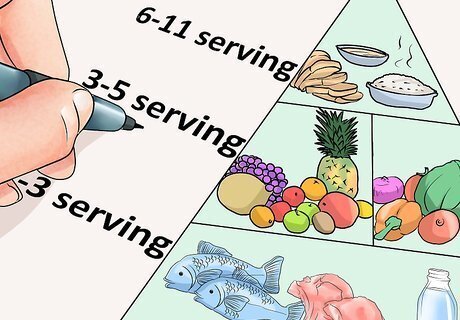
Mark the number of servings for each section. Section size and pictures give you a visual idea of how much of each group should be consumed, but placing the number of servings is a more accurate representation. Serving size is a good way to evaluate how much you are eating because the labels on packages at the grocery store are required to reveal the number of servings of all foods that you buy. The number of servings depends on how many calories you need to consume for a healthy diet. For example, 1,600 calories is enough for older adults and sedentary women; 2,200 calories is sufficient for children, teenage girls, active women, and sedentary men; and 2,800 calories is suitable for teenage boys, active men, and very active women. These three calorie levels are labeled as lower, moderate, and higher, which accounts for the range of suggested serving size. You must decide which level you fit best under. On the pyramid, label the grain group 6-11 servings; the vegetable group 3-5 servings; the fruit group 2-4 servings; both the milk and meat groups are 2-3 servings each; and the fats, oils, and sweets should be labeled as “use sparingly.”
Translating the Food Pyramid
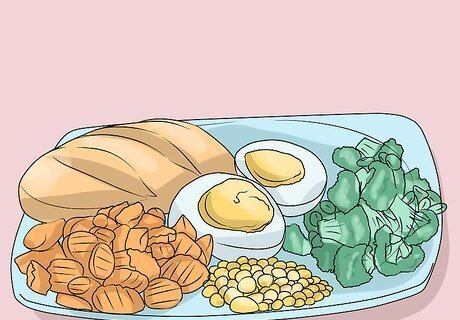
Select a variety of foods. There is no super food that contains all the necessary, protein, vitamins, minerals, and fibers needed for a healthy diet. Instead, food contains combinations of these requirements and, therefore, you need to diversify the food you eat from the five major food groups on the food pyramid. Because we often eat food that we enjoy and are familiar with preparing, it is difficult to diversify our diet. Try to moving away from eating the same or similar foods on a regular basis. Think about balance: people often choose higher or lower amounts from some food groups more than other that is suggested in the food pyramid. Food with beautiful colors – red, yellow, and green – usually found in fruits and vegetables, is very healthy. In other words, eat with your eyes. If it is too difficult to make whole sale changes in your diet, consider changing out just one portion at a time or adding something different to each meal. Most people love leftovers, but usually leftovers cannot be a meal in itself. Add vegetables or whole grain breads to your leftovers to make a more complete meal.
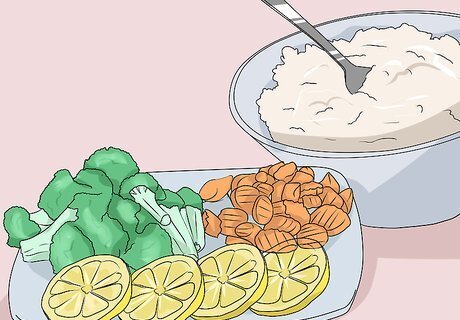
Eat plenty of fruits, vegetables, and grains. There is a reason why these three categories are the largest spaces on the pyramid and contain the highest number of servings – because they are the healthiest. Eating plenty of these foods will make you feel full and leave less room for fat, sugar, and oils. Vegetables and fruits contain important vitamins A and C, folate, iron, and magnesium, and are low in fat and sodium. Dark, leafy vegetables like broccoli, spinach, and romaine contain fiber and are known to prevent some cancers and restore damaged skin. Deep, yellow vegetables such as carrots and sweet potatoes contain large amounts of antioxidants that protect against cardiovascular disease and cancer. Choose from fresh fruit and fruit juices and either frozen, canned, or dried fruits to meet the required amount of servings. Avoid heavy syrups or added sugar products claiming to be fruit products. Citrus fruits, melons, and berries are rich in vitamin C, packed with antioxidants, and are a delicious alternative for desert compared to sugary cakes and pies.

Choose foods low in fat and cholesterol. The food pyramid focuses specifically on fat intake because research finds that the America diet is too high in fat. Therefore, the food pyramid is designed to lower the intake of fatty foods and cholesterol. Avoiding these two deadly ingredients will reduce your chances of getting heart disease, cancer, and help you maintain an ideal weight. Fat should never be more than thirty percent of your total calorie intake. Just by eating the healthy food listed on the food pyramid with the lowest fat content, you will consume fifty percent of total fat suggested by the USDA. Try not to constantly check how many grams of fat you eat every day. Instead, check it once or twice a week just to make sure you are staying within the guidelines. In particular, avoid saturated fats found in meat and dairy products because they could increase your risk for heart disease. Although cholesterol is similarly found in meat and dairy products and causes increase risk of heart disease, they are not the same as saturated fats, but should also be avoided.

Avoid large amounts of added sugar. Added sugars, not those that are naturally found in fruits, contain no nutritional value and, instead, make you fatter and more prone to diseases and cancers. Sugars include white, brown, and raw, as well as corn syrup, honey, and molasses. Added sugars can be found in most of the foods we enjoy like ice cream, candy, soda, jams and jellies. Try to limit added sugars to six teaspoons to a low calorie diet; twelve teaspoons to a moderate calorie diet; and 18 teaspoons to a high calorie diet to minimize potential damage.
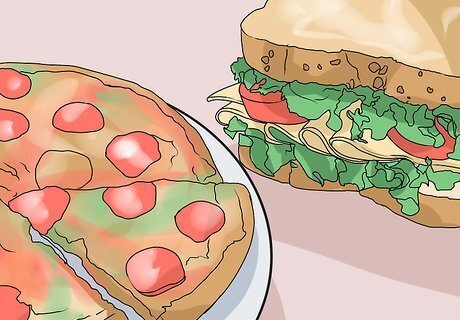
Pass on salt and sodium. Salt in itself is not bad, the problem stems from added salt during cooking or seasoning food that already contains salt. In other words, be mindful of food labels since they reveal how much salt or sodium is already present in the food. r An abundance of sodium in your body causes water retention, which places an extra burden on the heart and blood vessels causing high blood pressure. This could lead to more serious problems like a heart attack or stroke. Instead of using table salt, substitute it with herbs, spices, vinegar, or citrus juice. Try to purchase unsalted or low sodium foods.
Making the Food Pyramid Work

Keep a food journal. Every time you go grocery shopping or dine out, write down what you buy and what you eat. This way you can have a better idea of what sections on the pyramid you are fulfilling. Try doing this for a week to one month. Keep the journal with you to immediately record everything you eat and drink. Try to be honest and accurate. Record the date and time when you are eating. At the end of each day, examine what you have eaten and decide if you need to eat better.
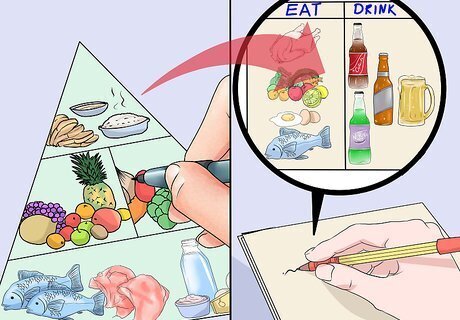
Match journal entries to the food pyramid. After compiling a record of the foods you ate, serving sizes, and the amount of fat, match it to the food pyramid that you made. Determine whether you are meeting the recommended amount of servings for each category. If not, consider what is preventing you from achieving your goals. Search for patterns in your food choices. It is not unusual to buy a box of cereal and have it every day until the box is empty. It might be, however, a better idea to buy two boxes or more to mix it up and maybe on the weekend, with more time, you can prepare something more elaborate like pancakes with fruit. Be aware of how many snacks you routinely have. A cookie here, a brownie there, a scoop of ice cream after dinner really adds up and they are all in the category that suggests moderation or zero servings. These types of snacks leave you hungrier than if you eat a piece of fruit, which contains filling fiber and healthy sugars. Do you eat healthier during the week while at work or on the weekend with more time on your hands? Time management has plenty of influence on diets. If you eat healthier on the weekends because you have more time, consider making extra healthy helpings that you can put in the refrigerator to eat during the busy weekdays. Keep frozen and canned vegetables in stock to supplement the main course. Grab a fresh apple, orange, or banana on your way out the door.
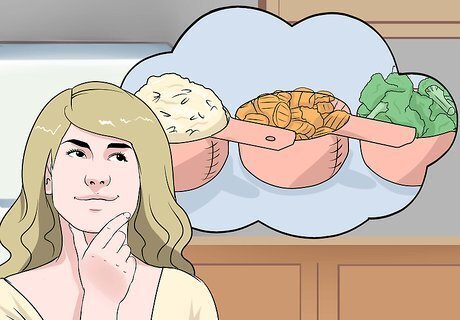
Evaluate the size of your portions. The most difficult part of accessing your diet compared to the guidelines proposed by the food pyramid is determining how much you really ate. Even when you think you are eating healthy foods, too much is still too much. Therefore, evaluating the serving size of what you eat may be the most important part of understanding the food pyramid. Although not always practical, the best determination of serving size is to measure it. It might be handy to make a compact chart that you can carry outside of the house or whenever you cannot use measuring cups. If dining out, record what you ordered or take a picture of it with your cell phone so that when you return home, you can better estimate the serving size.



















Comments
0 comment